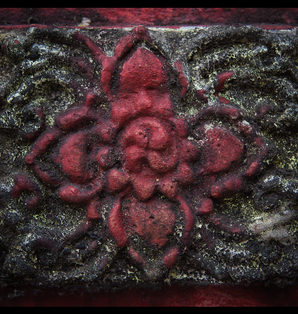As the great light shining in the darkness of night, the moon was regarded as one of the supreme images of the Goddess, the unifying power of the Mother of All. She was the measure of the cycles of time, and of celestial and earthly connection and influence. She governed the fecundity of women, the waters of the sea and all the phases of increase and decrease. The seasons followed each other in sequence as the phases of the moon followed each other. She was an enduring image of both renewal in time and of timeless totality, because what was apparently lost with the waning moon was restored with the waxing moon. Duality, imagined as the waxing and waning moon was contained and transcended in her totality.
- The Myth of the Goddess
- The Myth of the Goddess
Śūnyatā
The title of my composition Śūnyatā (pronounced "shoonyata") is a Sanskrit word which has multiple meanings depending on its doctrinal context. It is generally described as a Buddhist concept of 'emptiness' where everything is interconnected in a state of constant flux. Whilst composing the work I surrounded myself with symbols from Neolithic Goddess mythology and resonated with the concept of a deep spiral which grounds us to the earth and traces lines to our ancient ancestors.
The opening of the piece sees the whole orchestra breathing together like a giant 'yogic breath'. The deep spiral gradually begins and the orchestra wakes together like a sleeping giant. The focus of the work is largely textural and attempts to evoke concepts of timeless totality and transcendence to other dimensions.
Some quotes from the book "The myth of the Goddess: Evolution of an image" by Anne Baring and Jules Cashford
were particularly inspiring:
"The Bird Goddess appears as the vessel that is both labyrinth and door to the dimension beyond human life"
"The cosmic egg of the universe was laid by the cosmic mother bird, and its cracking open was the beginning of time and space."
"She (the Goddess) governed the fecundity of woman….. She was an enduring image of both renewal in time and timeless totality"
Year: 2021
Instrumentation: 2 Flutes (2nd doubling piccolo), oboe, cor anglais, clarinet in Bb, bass clarinet in Bb, bassoon, contrabassoon, 2 horns in F, trumpet Bb, trombone, bass trombone, tuba, percussion, harp, strings.
Duration: 10 min.
Difficulty: Advanced — Extended techniques and instrument preparations
Dedication note: Dedicated to John Hill.
Commission note: Commissioned by Composing women - Sydney Conservatorium of Music, Tasmanian Symphony Orchestra.
First performance: by Tasmanian Symphony Orchestra, Simon Reade — 14 Jun 21. Hobart
The composer notes the following styles, genres, influences, etc. of this work:
textural, microtonal, orchestral, extended techniques, preparation, preparations, filmic, film, drone, melody, melodic, cello solo, breath.
Finalist Nomination
|
More
Musical ScoreView the Score here
|
Listen |
Album ArtworkArtwork by Rachelle Kellett
@rachellekellett . This piece really encapsulates the underlying inspiration for the work, Neolithic Goddess Mythology. This design makes me envisage the orchestra as a sleeping giant awakening from it’s slumber. |




